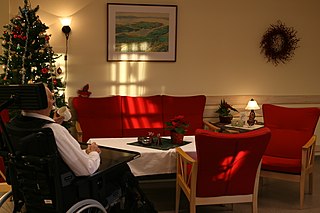Supportive housing is a combination of housing and services intended as a cost-effective way to help people live more stable, productive lives, and is an active "community services and funding" stream across the United States. It was developed by different professional academics and US governmental departments that supported housing. Supportive housing is widely believed to work well for those who face the most complex challenges—individuals and families confronted with homelessness and who also have very low incomes and/or serious, persistent issues that may include substance use disorders, mental health, HIV/AIDS, chronic illness, diverse disabilities or other serious challenges to stable housing.
Developmental disability is a diverse group of chronic conditions, comprising mental or physical impairments that arise before adulthood. Developmental disabilities cause individuals living with them many difficulties in certain areas of life, especially in "language, mobility, learning, self-help, and independent living". Developmental disabilities can be detected early on and persist throughout an individual's lifespan. Developmental disability that affects all areas of a child's development is sometimes referred to as global developmental delay.

Long-term care (LTC) is a variety of services which help meet both the medical and non-medical needs of people with a chronic illness or disability who cannot care for themselves for long periods. Long-term care is focused on individualized and coordinated services that promote independence, maximize patients' quality of life, and meet patients' needs over a period of time.
Person-centred planning (PCP) is a set of approaches designed to assist an individual to plan their life and supports. It is most often used for life planning with people with learning and developmental disabilities, though recently it has been advocated as a method of planning personalised support with many other sections of society who find themselves disempowered by traditional methods of service delivery, including children, people with physical disabilities, people with mental health issues and older people. PCP is accepted as evidence based practice in many countries throughout the world.

Inclusion in education refers to all students being able to access and gain equal opportunities to education and learning. It arose in the context of special education with an individualized education program or 504 plan, and is built on the notion that it is more effective for students with special needs to have the said mixed experience for them to be more successful in social interactions leading to further success in life. The philosophy behind the implementation of the inclusion model does not prioritize, but still provides for the utilization of special classrooms and special schools for the education of students with disabilities. Inclusive education models are brought into force by educational administrators with the intention of moving away from seclusion models of special education to the fullest extent practical, the idea being that it is to the social benefit of general education students and special education students alike, with the more able students serving as peer models and those less able serving as motivation for general education students to learn empathy.
"The normalization principle means making available to all people with disabilities patterns of life and conditions of everyday living which are as close as possible to the regular circumstances and ways of life or society." Normalization is a rigorous theory of human services that can be applied to disability services. Normalization theory arose in the early 1970s, towards the end of the institutionalisation period in the US; it is one of the strongest and long lasting integration theories for people with severe disabilities.

Deinstitutionalisation is the process of replacing long-stay psychiatric hospitals with less isolated community mental health services for those diagnosed with a mental disorder or developmental disability. In the late 20th century, it led to the closure of many psychiatric hospitals, as patients were increasingly cared for at home, in halfway houses and clinics, in regular hospitals, or not at all.
Wolf Peregrin Joachim Wolfensberger, Ph.D. (1934–2011) was a German American academic who influenced disability policy and practice through his development of North American Normalization and social role valorization (SRV). SRV extended the work of his colleague Bengt Nirje in Europe on the normalization of people with disabilities. He later extended his approach in a radical anti-deathmaking direction: he spoke about the Nazi death camps and their targeting of disabled people, and contemporary practices which contribute to deathmaking.

The Burton Blatt Institute (BBI), established at Syracuse University in 2005, is an organization that aims to advance civic, economic, and social participation of persons with disabilities in a global society. Peter Blanck, a University Professor at Syracuse University, is the chairman of BBI.
A group home, congregate living facility, care home, adult family home, etc., is a structured and supervised residence model that provides assisted living and medical care for those with complex health needs. Traditionally, the model has been used for children or young people who cannot live with their families or afford their own homes, people with chronic disabilities who may be adults or seniors, or people with dementia and related aged illnesses. Typically, there are no more than six residents, and there is at least one trained caregiver there 24 hours a day. In some early "model programs", a house manager, night manager, weekend activity coordinator, and four part-time skill teachers were reported. Originally, the term group home referred to homes of 8 to 16 individuals, which was a state-mandated size during deinstitutionalization. Residential nursing facilities, also included in this article, may be as large as 100 individuals in 2015, which is no longer the case in fields such as intellectual and developmental disabilities. Depending on the severity of the condition requiring one to need to live in a group home, some clients are able to attend day programs and most clients are able to live normal lifestyles.
Psychiatric rehabilitation, also known as psychosocial rehabilitation, and sometimes simplified to psych rehab by providers, is the process of restoration of community functioning and well-being of an individual diagnosed in mental health or emotional disorder and who may be considered to have a psychiatric disability.
Supported employment refers to service provisions wherein people with disabilities, including intellectual disabilities, mental health, and traumatic brain injury, among others, are assisted with obtaining and maintaining employment. Supported employment is considered to be one form of employment in which wages are expected, together with benefits from an employer in a competitive workplace, though some versions refer to disability agency paid employment. Companies such as Skilcraft in the United States are an example of "supported employment" which is defined in law for state and federal reimbursements.

John O'Brien is a leading thinker who has written widely in the field of disability. He is a pioneer and lifelong advocate of Person Centred Planning. To this end, he was co-developer of two models for person centred planning, namely the McGill Action Planning System (MAPS) and Planning Alternative Tomorrows with Hope (PATH). His values based approach emphasises learning with each person about the direction their lives could take, challenging and overcoming practices, structures and values that lead to segregation and underestimation rather than inclusion, and an approach to change in people's lives based on 'imagining better'. His thinking is based on Social Role Valorisation and the Social model of disability. He is an Associate Editor of Mental Retardation, and on the Advisory Boards of the Georgia Advocacy Office and Georgia PASS. With Herbert Lovett, O'Brien co-wrote “Finding A Way Toward Everyday Lives,” a paper cited by others in the disabilities field as a significant reference point in the early development of person-centered planning.
The Family Movement, also known in the past as the Parent Movement, is an arm of the disability rights movement, a larger social movement. The Family Movement advocates for the economic and social rights of family members with a disability. Key elements include: social inclusion; active participation; a life of meaning; safety; economic security; accessibility and self-determination. The family movement has been critical in closing institutions and other segregated facilities; promoting inclusive education; reforming adult guardianship to the current supported decision-making; increasing access to health care; developing real jobs; fighting stereotypes and reducing discrimination.
Community integration, while diversely defined, is a term encompassing the full participation of all people in community life. It has specifically referred to the integration of people with disabilities into US society from the local to the national level, and for decades was a defining agenda in countries such as Great Britain. Throughout recent decades, community integration programs have been increasingly effective in improving healthcare access for people with disabilities. They have been valued for providing a "voice for the voiceless"
Family support is the support of families with a member with a disability, which may include a child, an adult, or even the parent in the family. In the United States, family support includes "unpaid" or "informal" support by neighbors, families, and friends, "paid services" through specialist agencies providing an array of services termed "family support services", school or parent services for special needs such as respite care, specialized child care or peer companions, or cash subsidies, tax deductions or other financial subsidies. Family support has been extended to different population groups in the US and worldwide. Family support services are currently a "community services and funding" stream in New York and the US which has had variable "application" based on disability groups, administrating agencies, and even, regulatory and legislative intent.
Gunnar Dybwad (1909–2001) was an American professor and advocate for the rights of people with disabilities, particularly developmental disabilities. He is best known for his support for the social model of disability, reframing disability accommodations as a matter of civil rights, not medical treatment. The American Association on Intellectual and Developmental Disabilities gives out the Dybwad Humanitarian Award annually in his honor.
For many elderly carers of a relative who has a learning or other disability, future planning is an issue. The population of older parents who have children with a learning disability is growing and many of their children are likely to outlive them. In many cases the caring role can span up to seven decades, ending only with their death. Governments and other service providers cannot ignore the pressing needs of this population and their parent and sibling carers. In most countries, family carers provide inexpensive care for a person with a learning disability and other disabilities. This trend is set to continue in England. Demographic changes and the health needs of these two growing populations must be considered against government policy constraints and limited in-home and external care options in order to avoid a crisis. The consequences of not supporting these family carers will lead to crisis management, increase in distress and care giving burdens, and increased spending on unsuitable crisis placements. Housing and financial guidance are issues for caregivers.
As of 2017, approximately 1.4 million Americans live in a nursing home, two-thirds of whom rely on Medicaid to pay for their care. Residential nursing facilities receive Medicaid federal funding and approvals through a state health department. These facilities may be overseen by various types of state agency.
The Connecticut Department of Developmental Services (DDS) is a state agency of Connecticut providing services to individuals with developmental disabilities and their families. Its headquarters are in Hartford. According to its official Twitter description, "CT DDS serves more than 20,000 individuals [with] intellectual disability and their families, including 4,000 infants and toddlers in the Birth to Three System."





